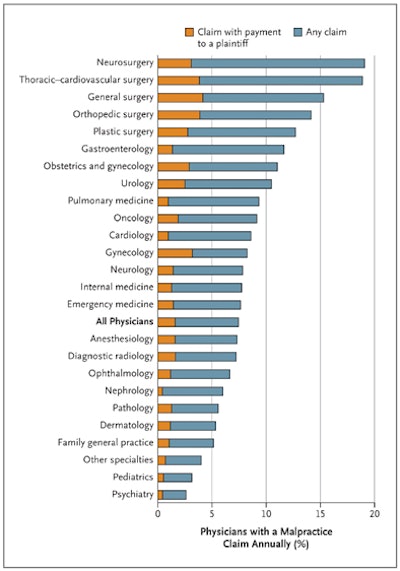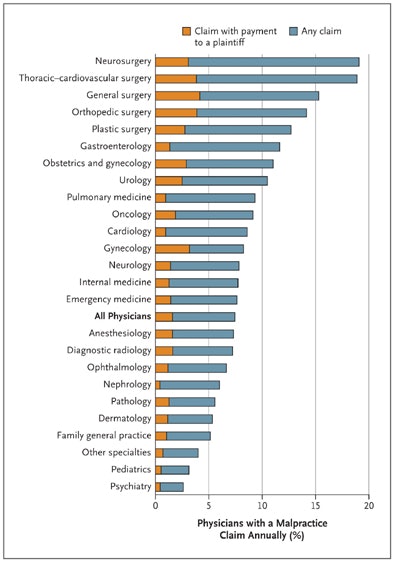
Radiologists are dragged into court less often than some other specialists -- and less often than they may think. According to a New England Journal of Medicine study that analyzed 14 years of data, radiologists' chances of being hit with a malpractice suit and the resulting payouts were both slightly lower than for other physicians.
Researchers from Massachusetts General Hospital (MGH) and several other U.S. institutions found that radiologists ranked 18 among 25 medical specialties based on the risk of being sued for malpractice, at 7.2% versus the overall average of 7.4% of all physicians, with lower-than-average payouts.
Study co-author Amitabh Chandra, PhD, from Harvard University, said the low lawsuit rate for diagnostic radiology didn't surprise him. "When injury occurs, it's much easier to associate the injury with someone who's doing something invasive, like surgery, or the doctor who should have ordered a test in the first place" but failed to do so, Chandra said in an interview with AuntMinnie.com.
Filling in the gaps
Previous studies leave serious gaps in the data with regard to the number of doctors who face malpractice claims in a year, the size of claims, and the cumulative career malpractice risk by specialty, wrote lead author Dr. Anupam Jena, PhD, from MGH, and colleagues.
"Each of these earlier studies has limitations, including the use of older data with limited geographic coverage, reliance on self-reports with limited sample size and low response rates, limited information on physician specialty, and a lack of information on the size of payments," the authors wrote (NEJM, August 18, 2011, Vol. 365, pp. 629-636).
The group looked at U.S. malpractice data from 1991 through 2005 for all physicians who were covered by a single large professional liability insurer with a nationwide client base including 40,916 physicians and 233,738 physician-years of coverage. Dividing the claims into 25 specialties, they reported the proportion of physicians who had malpractice claims in a year, the proportion of claims leading to an indemnity payment (compensation paid to a plaintiff), and the size of the indemnity payments. Finally, they estimated the cumulative risk of ever being sued among physicians in both high- and low-risk specialties, defined as the five specialties with the highest and lowest proportions of physicians with a claim in a year.
The sample was separated into three periods to investigate how claim rates varied over time for high- and low-risk specialties. The researchers characterized the size of malpractice payments by computing mean and median payments and extracting awards greater than $1 million to suppress outliers. Finally, they analyzed the data to estimate the cumulative career malpractice risk for each specialty.
The results showed that "each year during the study period, 7.4% of all physicians had a malpractice claim, with 1.6% having a claim leading to a payment (i.e., 78% of all claims did not result in payments to claimants)," they wrote. The percentage of physicians facing a claim each year included 19.1% in neurosurgery, 18.9% in thoracic-cardiovascular surgery, 15.3% in general surgery, 7.2% in radiology, 5.2% in family medicine, 3.1% in pediatrics, and 2.6% in psychiatry.
 |
| Proportion of physicians facing a malpractice claim annually, according to specialty. Image courtesy of NEJM. |
"The likelihood that a radiologist experienced any claim in a year was approximately 7.2%, and the likelihood that they experienced a claim in a year that resulted in an indemnity payment was about 1.6%," noted co-author Seth Seabury, PhD, from research and analysis firm RAND, in an e-mail to AuntMinnie.com. "This [is] compared to the overall average of 7.4% and 1.6%, respectively, so it's probably accurate to say that radiology has close to average risk. The average payment in radiology was about $236,906, compared to the overall mean of $274,887. So [radiology] payments were below average."
Compared to diagnostic radiology, the only specialties showing lower percentages of practitioners being sued were ophthalmology, nephrology, pathology, dermatology, family general practice, pediatrics, and psychiatry.
"Interestingly, the specialties in which physicians were most likely to face malpractice claims weren't always the ones in which indemnity claims were most prevalent," Jena and colleagues wrote, noting that estimates of overall and paid claims were unaffected by adjustments for physician age, year, and state of practice.
The cumulative number of suits was significant over a radiology career, however. By the age of 65 years, 75% of physicians in low-risk specialties and 99% of those in high-risk specialties were projected to face a claim, according to the authors.
Importantly, the study revealed that many claims do not result in payments to a plaintiff, the authors noted. Annual claim rates leading to indemnity payments ranged from 1% to 5% across the 25 specialties, compared to rates of all claims ranging from 5% to 22%.
"Our projections suggest that nearly all physicians in high-risk specialties will face at least one claim during their career; however, a substantial minority will not have to make an indemnity payment," they wrote.
Are radiologists whiners?
The results may address why physicians consistently report concern over malpractice and the intense pressure to practice defensive medicine, despite evidence that the scope of defensive medicine is modest. Physicians' concern about their malpractice risk varies far less across states than do objective measures of malpractice risk, including paid claims, average payments, malpractice premiums, and tort reforms, the authors concluded.
"For example, 65% of physicians practicing in states in the bottom third of rates for paid malpractice claims (5.5 paid claims per 1,000 physicians) express substantial concern over malpractice, as compared with 67% of physicians in the top third (14.6 claims per 1,000 physicians)," Jena and colleagues wrote. "Although these annual rates of paid claims are low, the annual and career risks of any malpractice claim are high, suggesting that the risk of being sued alone may create a tangible fear among physicians."
Do radiologists in particular overestimate their risk of a malpractice suit?
"Do I know that for a fact -- no -- but it's my sense that they do," Chandra told AuntMinnie.com. "Every time I meet radiologists they do complain more loudly than the actual specialties being sued the most; there's something in the radiology DNA. I'm not saying [radiologists] are not being sued because [they] are being sued, and it's horrible because [they] have to bear the emotional and hassle costs of being sued."
In Chandra's view, most radiology lawsuits waste time and money without addressing the core problem.
"Those are costs that weigh heavily on physicians' minds, and they have no social value because they don't result in better care, nor do they result in corrective justice," he said. "It's not like because the radiologist suffered in hassle costs, the patient was made whole -- that doesn't happen. It's all symptomatic of a broken justice system. If I had a wand, I would look at the entire problem, not make it easier for the radiologists. Anesthesiologists are good at complaining, too."
The traditional approaches to tort reform -- caps on damages -- aren't particularly helpful because they don't limit the frequency with which doctors are sued, Chandra said. The goal should be to reduce the number of lawsuits, and for certain high-risk procedures such as birth injuries it might help to introduce "no-fault insurance, just like we do for vaccines," he said. Money would come out of a pool, "but there's no reason to sue the doctor in these cases," he said. For other types of cases, make the doctor's apology inadmissible in court, because there is evidence that the doctor's apology can reduce the likelihood of a lawsuit, he said.
New data on the way will begin to break down radiology by procedure rather than for the specialty as a whole, Chandra said. However, for now, there's no way to demonstrate with the current data that some procedures are riskier for malpractice than others.
Perception versus reality
As for the idea that radiologists have an outsized impression of their risk of being sued, it's probably true, said malpractice expert Dr. Leonard Berlin, vice chair of radiology at NorthShore University HealthSystem in Illinois.
"Perception is always worse than reality; we know that," Berlin said, and interestingly, a survey of mammographers three years ago showed that "the worry about getting sued is four times the reality," he said. "Are physicians overdefensive about malpractice? Sure they are." But it's important to keep in mind that "the most frequent allegations in the U.S. for the past 20 years are missed breast cancer and birth injuries." So the study might underestimate ob/gyn injuries (gynecology's rate was just slightly greater than the 7.4% overall average), as well as radiology.
Chandra said he was unaware of figures in line with Berlin's take on those two procedures. "We spent a lot of time ensuing that our results were similar to those from other nationally representative datasets," he said. "If we had done the weighting wrong, we would not [have gotten] comparable results."
Berlin took issue with other areas of the study data, saying that although the numbers were almost certainly calculated correctly, the underlying data from the single large insurer wasn't necessarily representative of the U.S. as a whole.
First, he said, radiologists comprised just 2% of the physicians in the survey, while they comprise about 10% of the specialists in the U.S. Second, it's impossible to know how the states are weighted in the insurer's data, and the state matters, he said.
What is relevant is not the 2% or 10% sample of radiologists, but "whether we sampled the 10% of radiologists randomly," Chandra responded.
"Are the radiologists in private practice, [or] are they in large teaching hospitals?" Berlin asked. "Clearly, the playing field is different, and there are no distribution specifics in the study and they're lumping everybody together. Private practice radiologists get sued more."
Second, there are the geographic differences, which also were not addressed in the study.
"Certain states -- Illinois, New York, Pennsylvania -- are high-profile states where lots of money is paid out," and they stand in stark contrast to states such as Wyoming, North Dakota, and South Dakota that are more restrictive, Berlin said. "Texas now has very little in payouts because of tremendous tort reform." But while the study includes ranges for payouts, it doesn't address distribution, offering no clue as to where the payouts were concentrated.
Third, the Physician Insurers Association of America (PIAA), which compiles data from approximately 30 insurers across the U.S., pegs the percentage of indemnifications or payouts at 33% of all cases, while the study's single insurer sets the figure at about 25%, Berlin said.
"We weighted each state according to the number of doctors in it," Chandra responded. "So if Texas had more doctors than Illinois, Texas got that much more weight. We did not overweight the states that had more malpractice. That would be wrong." So while Berlin "raises some relevant questions, they're all dealt with in the paper," Chandra said.
The authors concluded that there is substantial variation in the likelihood of malpractice suits and the size of indemnity payments across the 25 medical specialties. The cumulative risk of facing a malpractice claim is high in all specialties, although only a small percentage of claims lead to payments to plaintiffs.



















